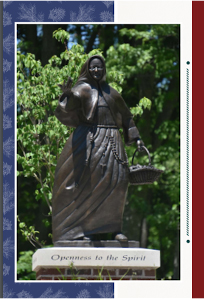The Ancilla Domini Chapel dominates the center wing of the main building of the Motherhouse for the Poor Handmaids of Jesus Christ in the U.S. province. The first Sisters came from Germany in 1868 and settled near Fort Wayne, Indiana. In 1918 they purchased property just beyond Donaldson for retreat, rest and recreation. On May 24, 1923, the “Chapel in the Corn Field” was dedicated. The architecture of the Ancilla Domini Chapel expresses a great movement of the human spirit. The neo-Gothic columns of the nave soar up as if reaching toward heaven.
The columns are decorated with the ancient Greek and Roman design, the Corinthian style, used often by the Romans in their adaptations of Greek forms. Frances Xavier Zettler of the Royal Barvarian Institute of Munich, Germany designed the German baroque style of stained glass windows. The altars are made of butternut and golden oak and were made in LaCrosse, Wisconsin and hauled to Donaldson in freight wagons. All the statues are woodcarvings from Germany. On the unique ceiling are featured images of angels supporting symbols of Mary as queen. Louis Van Dinter as his last masterpiece built the large organ.
The pipes were made in Pennsylvania by Gottfried, a firm famous for the art of voicing organ pipes. The organ has 21 ranks in three divisions and 1,291 pipes. The interior was painted for the first time in 1951; the centennial of the order’s beginning in Dernbach, Germany. Master artists from the DaPrado Studio in Chicago used the many shades of gray in the design. The PHJC Ministry Center with its beautiful grounds and prayer garden is located on the shore of Lake Gilbraith. Worship is the purpose of this chapel – to respond to God’s unconditional love through beauty, music, words and actions.
Ecumenical groups frequently enjoy this worship space. It is a place of prayer for people of all faiths. The Ancilla Domini Chapel is open to all that visit the PHJC Ministry Center.

